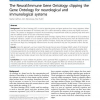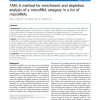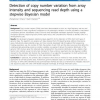BMCBI
2010
13 years 11 months ago
2010
Background: Sequencing of environmental DNA (often called metagenomics) has shown tremendous potential to uncover the vast number of unknown microbes that cannot be cultured and s...
BMCBI
2010
13 years 11 months ago
2010
Background: Flux variability analysis is often used to determine robustness of metabolic models in various simulation conditions. However, its use has been somehow limited by the ...
BMCBI
2010
13 years 11 months ago
2010
Background: Protein structure comparison is a central issue in structural bioinformatics. The standard dissimilarity measure for protein structures is the root mean square deviati...
BMCBI
2010
13 years 11 months ago
2010
Background: It is hypothesized that common, complex diseases may be due to complex interactions between genetic and environmental factors, which are difficult to detect in high-di...
BMCBI
2010
13 years 11 months ago
2010
Background: The Gene Ontology (GO) is used to describe genes and gene products from many organisms. When used for functional annotation of microarray data, GO is often slimmed by ...
BMCBI
2010
13 years 11 months ago
2010
Background: MicroRNAs (miRNAs) are a class of important gene regulators. The number of identified miRNAs has been increasing dramatically in recent years. An emerging major challe...
BMCBI
2010
13 years 11 months ago
2010
Background: Non-coding RNAs gain more attention as their diverse roles in many cellular processes are discovered. At the same time, the need for efficient computational prediction...
BMCBI
2010
13 years 11 months ago
2010
Background: Extensive and automated data integration in bioinformatics facilitates the construction of large, complex biological networks. However, the challenge lies in the inter...
BMCBI
2010
13 years 11 months ago
2010
Background: The decrease in cost for sequencing and improvement in technologies has made it easier and more common for the re-sequencing of large genomes as well as parallel seque...
BMCBI
2010
13 years 11 months ago
2010
Background: Copy number variants (CNVs) have been demonstrated to occur at a high frequency and are now widely believed to make a significant contribution to the phenotypic variat...



